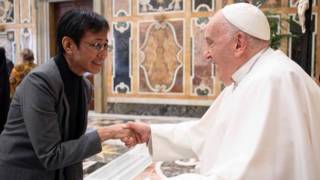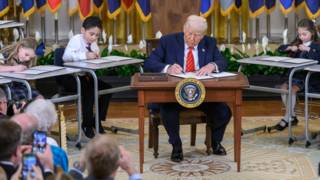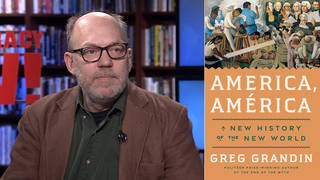
Reagan’s budget cuts and overhaul of tax codes led to an explosion of homelessness in the U.S. during his 8 years in power. We speak with Carol Fennelly, a leading activist on homeless issues during the Reagan presidency. [Includes transcript]
Throughout the week, Ronald Reagan has been praised almost non-stop on television, in newspapers and in magazines. Politicians and pundits from both establishment political parties have been practically falling over each other to heap praise on Reagan. And as he is glorified for what are termed his accomplishments and legacy, there is one term that was rose to prominence during Reagan’s time in power that is seldom mentioned. That is “homelessness.”
In fact many homeless rights activists say the single most devastating thing Reagan did to create homelessness was when he cut the budget for the Department of Housing and Urban Development by three-quarters, from $32 billion in 1981 to $7.5 billion by 1988. The department was the main governmental supporter of subsidized housing for the poor. Add this to Reagan’s overhaul of tax codes to reduce incentives for private developers to create low-income homes and you had a major crisis for low-income families and individuals. Under Reagan, the number of people living beneath the federal poverty line rose from 24.5 million in 1978 to 32.5 million in 1988.
And the number of homeless people went from something so little it wasn’t even written about widely in the late 1970s to more than 2 million when Reagan left office. But as Reagan proudly declared that the number of homeless shelters had increased significantly during his presidency, the homeless epidemic did not go ignored by everyone, especially not in Reagan’s back yard in Washington DC. Homeless rights activist Mitch Snyder and a dedicated group of homeless people and activists waged a many year campaign to win rights for people forced to live on the streets. Ultimately, they formed a movement based at what came to be known as the Community for Creative Non-Violence or CCNV. We are joined now by one of the people who was a leader of the homeless rights movement at CCNV during the Reagan years.
- Carol Fennelly, was a leading activist on homeless issues during the Reagan presidency. Along with Mitch Snyder, she was instrumental in establishing the Community for Creative Non-Violence in Washington DC. She is currently the Director of Hope House in Washington.
Transcript
AMY GOODMAN: Carol Fennelly. We welcome you as well to Democracy Now!.
CAROL FENNELLY: Thank you.
AMY GOODMAN: Can you describe these years?
CAROL FENNELLY: You know, I remember the month that Ronald Reagan was inaugurated president. Our soup line, which would grow from the beginning of the month to a short line, to a large line by the end of the month, and then it would drop down when people got their small checks or whatever. At the first part of the month, it could get small again and grow up through the end of the month. But that first month, it was almost as if there was some cosmic energy out there, you know, telling us what was coming in the future, but the first of the month rolled around and the line didn’t get shorter. It stayed the same. It grew and grew and grew and the soup lines just went around the block in those years. I mean it, was a very difficult time. There were not enough services. We were literally claiming people off streets who had frozen to death in Detroit and, you know, in the industrialized states like Michigan. People who were out of work went into double digit unemployment. There were around Houston, there was a tent city of homeless people, most of whom had come from the Midwestern, you know, states like Michigan. They were looking for work. They called them black tag people, because back then, Detroit had black license plates and they would pack up their families and go to Texas looking for work in the oil fields. It was a scene out of the depression. I mean, what people fail to remember is that we were in a massive recession during the early 1980s. People were out of work. People were homeless. When we hear about this great economic, you know, victory that Ronald Reagan had in the 1980s, I think, who wrote that history, because I wasn’t there.
AMY GOODMAN: At the same time, that the conditions you describe were intensifying, there is also a resistance movement that you are a part of. What did you do?
CAROL FENNELLY: We went on fasts, hunger strikes for months at a time. We went to jail a lot. You know, we built a Reaganville in Lafayette Park, and homeless people stayed in Reaganville for the whole winter one year. We ended up actually finally passing homeless legislation, the McKinney Act, that is still around. It was a huge victory for homeless people back in the mid to late middle 1980s. And, you know, it — there were great victories for us as well. But it cost us with our health and freedom as any social movement costs people who are active in it.
AMY GOODMAN: Can you tell the story of the rats?
CAROL FENNELLY: The rats. We were — actually, the rats were — there was someone who was living with us who used to collect rats out of the alley and go release them on the White House lawn on a regular basis. The other story there, though, is the cockroaches, which we released in the White House dining room. You know, we collected them and — you know, in our neighborhoods because we lived in a very poor neighborhood, that was overrun by rats and roaches, and we selected them and got on their White House tour line and went through and released them in the White House dining room. The message was that in the event of a nuclear attack, the only people left would be only — the only creatures left would be the cockroaches. We thought we should introduce them to some of their new housing.
AMY GOODMAN: We’re talking to Carol Fennelly of the C.C.N.V., the Community for Creative Non-Violence and Reverend Hagler. We’ll be joined by Francis Fox Piven and Dolores Huerta. We’re a talking about race and class and homelessness in the 1980s. Carol Fennelly, your final thoughts?
CAROL FENNELLY: You know, the city — I’m in Washington, too. And the city has been completely disrupted by this, you know, three-day grief glut we’re going through. I thought it was completely appropriate that President Reagan would be brought into town on Wednesday at rush hour. We do a teleconference program out of our office where kids can talk to their fathers in prison. We couldn’t get the kids to talk to their dads because the whole downtown was shut down. I thought the arrogance of that was so appropriate, because that’s what they did when they were here, you know. Completely oblivious to the needs of the people in this community and by extension, I think, the rest of the country.
AMY GOODMAN: I want to thank you all for being with us, Carol Fennelly, leading activist on homeless issues during the Reagan presidency.













Media Options